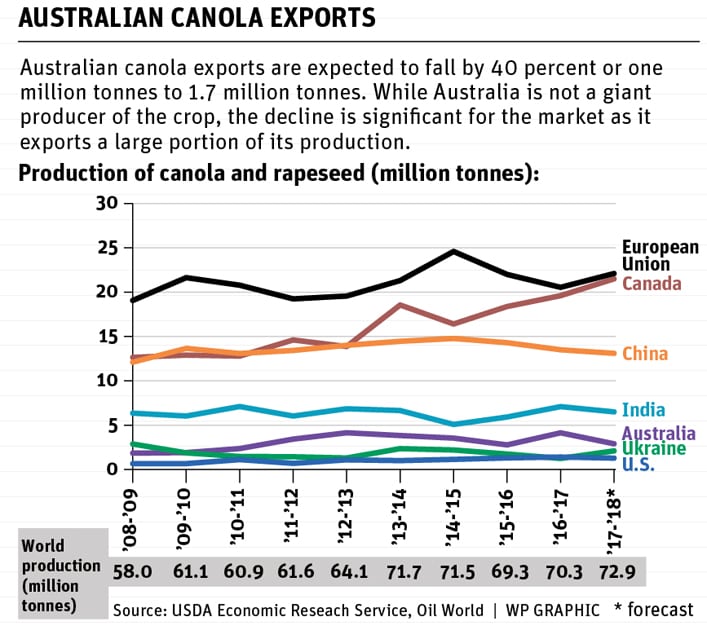Canadian farmers can expect less competition in canola and pulse markets from their Australian counterparts in 2018-19, according to a new Rabobank report.
Dry conditions and falling pulse prices are forcing farmers to switch acres out of those crops and into barley and wheat.
“A dry 2017, especially in eastern Australia, followed by a hot, dry summer opened this season with almost universally below-average soil moisture, in nearly all cases very much below or at record low,” according to Rabobank’s Australian Winter Crop Outlook.
Canola is the first casualty of the dryness with planting falling by 13 percent compared to last year as growers abandon the expensive oilseed crop in favour of cereals.
Read Also

Message to provincial agriculture ministers: focus on international trade
International trade stakeholders said securing markets in the face of increasing protectionism should be the key priority for Canada’s agriculture ministers.
Rabobank is also forecasting reduced yields.
“High-end yield prospects have been removed certainly for canola but increasing for wheat and barley with average yields and in some cases less than average yields considered likely,” report author Cheryl Kalisch Gordon said in a news release.
Canola exports are expected to plummet by nearly 40 percent or one million tonnes to 1.7 million tonnes.
Australian pulse prices are down 40 percent from their 2017 highs due to India’s pulse import duties and that is making it tough for chickpeas and lentils to compete with cereals.
Rabobank is forecasting a 13 percent decline in pulse plantings from 2017-18 levels. The report did not contain a pulse export forecast.
Neil Townsend, senior market analyst with FarmLink Marketing Solutions, generally puts a lot of faith in Rabobank reports.
“They actually have an amazingly good coverage of Australia. They know quite a bit about Australia. It’s not just like some guys in a bank sitting there and talking,” he said.
But in this case, he wonders if it may be premature to be reducing production prospects. When he saw the report, Townsend reached out to his Australian contacts for feedback.
“The general word I heard there is just that it’s very, very early to be so pessimistic,” he said.
However, Townsend doesn’t doubt that farmers are switching out of an expensive crop like canola and into less expensive options like wheat and barley given the dry conditions and parched soil.
If Rabobank turns out to be right and Australia is forced to shave off one million tonnes of canola exports, that would be good for Canadian canola prices.
However, he noted that the Black Sea region is expected to boost rapeseed production.
APK Inform forecasts 2.62 million acres in Ukraine, a 12 percent increase over last year and 2.96 million acres in Russia, a 19 percent increase.
Production is forecast at 2.43 million tonnes in Ukraine and 1.67 million tonnes in Russia. But there are rumours that Russia’s acres are higher than anticipated, which could result a two million tonne crop, said Townsend.
Rabobank is forecasting a 23 million tonne Australian wheat crop, which would be eight percent higher than last year’s drought-reduced crop.
“If we see a wheat crop of 23 million tonnes we could see Australian wheat exports fall to their lowest level in nine years at 15.5 million tonnes,” said Kalisch Gordon.
Bruce Burnett, director of markets and weather with Glacier MarketsFarm, said it is definitely too soon to be scaling back Australian wheat production.
“There’s time here yet for Australia,” he said.
Australia is dry but it is a dry region of the world and farmers there can hold off until August or even September to plant their wheat, so there is plenty of time for the rains to come.
The only thing that gives him pause is the potential for an El Nino weather event to evolve.
“That would be definitely negative for eastern Australian wheat,” said Burnett.

















